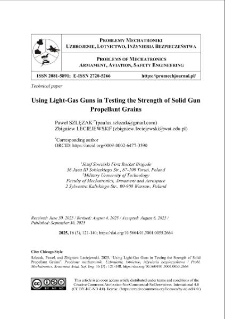Nasza Biblioteka Cyfrowa udostępnia 1 868 obiektów cyfrowych
Obiekt
Tytuł: Using Light-Gas Guns in Testing the Strength of Solid Gun Propellant Grains ; Using Light-Gas Guns in Testing the Strength of Solid Gun Propellant Grains
Tytuł odmienny:
Zastosowanie dział gazowych w badaniach wytrzymałościowych ziaren stałych materiałów miotających ; Zastosowanie dział gazowych w badaniach wytrzymałościowych ziaren stałych materiałów miotających
Współtwórca:
Zbigniew LECIEJEWSKI ; Zbigniew LECIEJEWSKI
Abstrakt:
NATO Standardisation Agreements (STANAGs) 4241 and 4496 outline destructive testing procedures to determine how gun propellants in artillery munitions behave when struck by a 12.7 × 99 mm anti-tank projectile travelling at approximately 850 m/s, or by a standardised fragment (shrapnel) made from specific material and shape, moving at 1830 or 2530 m/s. Unlike traditional live-fire testing of complete munitions at test ranges, it is now possible to theoretically simulate the results of collisions between objects with specified dimensions, mass, and velocity, whether they involve individual grains or gun propellants (charge) confined within a shell case. These simulations, however, require detailed knowledge of the strength properties of propellant grains under both static and dynamic loading conditions, particularly at the high rates of deformation that can be generated in laboratory experiments using the Taylor impact test or the Split Hopkinson Pressure Bar (SHPB) method. A light-gas gun is often used in these experimental setups, propelling the test specimen by means of energy from compressed gas, such as hydrogen, nitrogen, or helium. Based on the author’s experience with maintaining a straight-line trajectory for expelled propellant grains, as well as ensuring a parallel contact plane between the grain’s leading face and the fixed partition, a new testing approach has been proposed. This approach uses the direct impact Hopkinson Pressure Bar (DIHPB) technique. Of the various Hopkinson methods available, DIHPB was selected. In this method, a propellant grain is attached to the output bar’s face, and the striker impacts the grain’s front face. Strain gauges on the output bar measure the crushing force. The deformation of the propellant grain is then tracked using a non-contact measurement setup (digital image correlation, or DIC).
;
NATO Standardisation Agreements (STANAGs) 4241 and 4496 outline destructive testing procedures to determine how gun propellants in artillery munitions behave when struck by a 12.7 × 99 mm anti-tank projectile travelling at approximately 850 m/s, or by a standardised fragment (shrapnel) made from specific material and shape, moving at 1830 or 2530 m/s. Unlike traditional live-fire testing of complete munitions at test ranges, it is now possible to theoretically simulate the results of collisions between objects with specified dimensions, mass, and velocity, whether they involve individual grains or gun propellants (charge) confined within a shell case. These simulations, however, require detailed knowledge of the strength properties of propellant grains under both static and dynamic loading conditions, particularly at the high rates of deformation that can be generated in laboratory experiments using the Taylor impact test or the Split Hopkinson Pressure Bar (SHPB) method. A light-gas gun is often used in these experimental setups, propelling the test specimen by means of energy from compressed gas, such as hydrogen, nitrogen, or helium. Based on the author’s experience with maintaining a straight-line trajectory for expelled propellant grains, as well as ensuring a parallel contact plane between the grain’s leading face and the fixed partition, a new testing approach has been proposed. This approach uses the direct impact Hopkinson Pressure Bar (DIHPB) technique. Of the various Hopkinson methods available, DIHPB was selected. In this method, a propellant grain is attached to the output bar’s face, and the striker impacts the grain’s front face. Strain gauges on the output bar measure the crushing force. The deformation of the propellant grain is then tracked using a non-contact measurement setup (digital image correlation, or DIC).
Miejsce wydania:
Warszawa
;
Warszawa
Wydawca:
Wojskowa Akademia Techniczna ; Wojskowa Akademia Techniczna
Data utworzenia:
Data złożenia:
Data akceptacji:
Data wydania:
Rozmiar:
Identyfikator:
oai:ribes-88.man.poznan.pl:2745
Sygnatura:
doi:10.5604/01.3001.0055.2664 ; doi:10.5604/01.3001.0055.2664
ISSN elektroniczny:
ISSN drukowany:
Język:
Licencja:
kliknij tutaj, żeby przejść ; kliknij tutaj, żeby przejść
Właściciel praw:
Wojskowa Akademia Techniczna ; Wojskowa Akademia Techniczna
Strona początkowa:
Strona końcowa:
Tom:
Czasopismo:
Słowa kluczowe:
gun propellant grains, mechanical properties, dynamic loads, Taylor test, split Hopkinson pressure bar method, light-gas gun ; gun propellant grains, mechanical properties, dynamic loads, Taylor test, split Hopkinson pressure bar method, light-gas gun
Kolekcje, do których przypisany jest obiekt:
Data ostatniej modyfikacji:
17 paź 2025
Data dodania obiektu:
17 paź 2025
Liczba wyświetleń treści obiektu:
0
Wszystkie dostępne wersje tego obiektu:
https://ribes-88.man.poznan.pl/publication/3086
Wyświetl opis w formacie RDF:
Wyświetl opis w formacie OAI-PMH:
| Nazwa wydania | Data |
|---|---|
| Using Light-Gas Guns in Testing the Strength of Solid Gun Propellant Grains | 17 paź 2025 |
Obiekty Podobne
Patryk MODRZEJEWSKI Jacek JANISZEWSKI

